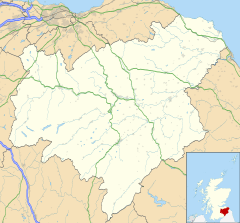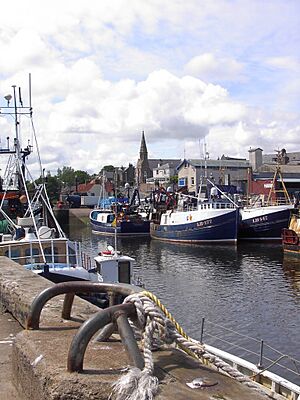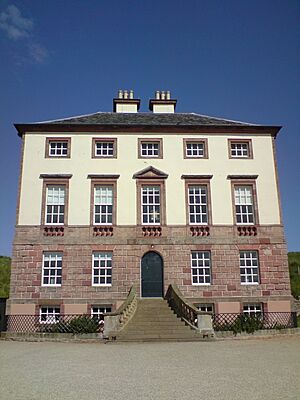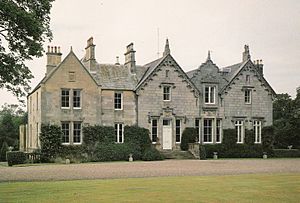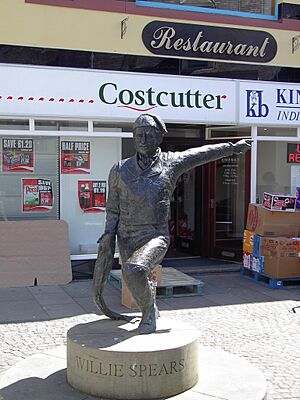Eyemouth facts for kids
Quick facts for kids Eyemouth |
|
|---|---|
 Eyemouth Harbour |
|
| Population | 3,580 (2020) |
| OS grid reference | NT944640 |
| • Edinburgh | 43 mi (69 km) |
| • London | 312 mi (502 km) |
| Civil parish |
|
| Council area | |
| Lieutenancy area | |
| Country | Scotland |
| Sovereign state | United Kingdom |
| Post town | Eyemouth |
| Postcode district | TD14 |
| Dialling code | 01890 |
| Police | Lothian and Borders |
| Fire | Lothian and Borders |
| Ambulance | Scottish |
| EU Parliament | Scotland |
| UK Parliament |
|
| Scottish Parliament | |
Eyemouth is a small town in Berwickshire, Scotland. It is part of the Scottish Borders area. The town is about 2 miles (3 km) east of the main A1 road and 8 miles (13 km) north of Berwick-upon-Tweed.
Eyemouth gets its name because it sits at the mouth of the Eye Water river. The coastline here has tall cliffs, clear water, sandy coves, and pretty harbours. Eyemouth is a busy fishing port. Every year, the town celebrates with a fun Herring Queen Festival.
You can find interesting buildings like Gunsgreen House in Eyemouth. There's also an old cemetery watch-house. It was built to guard against "Resurrectionists," who were people who illegally dug up bodies in the past. The town still has many features of a traditional fishing village, with narrow streets and special alleyways called "vennels."
Eyemouth is close to several small villages. These include Ayton, Reston, St Abbs, Coldingham, and Burnmouth. The coast around Eyemouth is great for birdwatching, walking, fishing, and scuba diving. If you visit, you can stay in hotels, B&Bs, or a holiday park.
Contents
Eyemouth's Old Forts
Fort Point in Eyemouth was once home to an important fortress. This was the first "trace-italienne" style fort in Britain. This type of fort has star-shaped walls that help defend against attacks. It was built on a piece of land overlooking the harbour.
Building started in 1547 by an English engineer named Sir Richard Lee. It cost a lot of money back then, about £1,906. Stones for the fort came from a demolished castle nearby, and wood was taken from Coldingham Priory.
The first fort was taken down in 1551 due to a peace treaty. But a bigger, more complex fort was built in 1557. This was done by French engineers for Mary of Guise, who was ruling Scotland at the time. This new fort could hold about 500 French soldiers. It was likely meant to store weapons and supplies safely near the border with England.
Even though the new fort might not have been fully finished, it was also scheduled to be demolished in 1559 because of another treaty. You can still see parts of the old fort walls today.
Eyemouth's Rich History
Eyemouth was part of a large area controlled by Coldingham Priory until the early 1600s. After that, the Clan Home family took over. They had owned land in the area for a long time.
The land near the Eye Water river had three main estates. These were Gunsgreen, right across from Eyemouth, and Netherbyres. Netherbyres was once part of a bigger area called Flemington.
In the early 1600s, Alexander Lauder owned the Gunsgreen estate. He was a descendant of a famous knight, Sir Robert Lauder.
The Netherbyres estate was owned by the Craw family for at least 250 years. A man named William Craw, who loved mathematics, built Eyemouth's first modern harbour. In 1715, he also built a unique elliptical (oval-shaped) walled garden.
The Netherbyres House you see today was started around 1835. It was built for Captain Samuel Brown of the Royal Navy. He held the patent for supplying anchor chains to the Royal Navy. He also designed and patented chain suspension bridges. One of his famous bridges is the Union Bridge over the River Tweed, which is still used today!
A local hero, William Spears (1812–1885), is honoured with a bronze statue in Eyemouth Market Place. He is shown pointing towards Ayton. Spears led a protest against taxes on fish. These taxes were collected by the Church of Scotland.
Soon after these fish taxes were removed, a terrible event hit the town. This was the Eyemouth Disaster on October 14, 1881. A huge storm caused most of the fishing fleet to be lost at sea. About 20 boats and 129 men from Eyemouth died. Including victims from other towns, 189 men lost their lives that day. This sad event is remembered in the Eyemouth Tapestry, which is displayed in the local museum.
In the late 1700s, Dutch engineers looked into building a canal. This canal would have linked Eyemouth to Duns. The plan involved changing the path of the Whiteadder Water river. However, the plan was never carried out.
From 1891 to 1962, Eyemouth had its own short railway line. It connected to Burnmouth on the main East Coast railway line. The line had to close for a while in 1948 due to flooding from the Eye Water.
John Churchill, 1st Duke of Marlborough was given the title "Lord Churchill of Eyemouth" in 1682. This was his first important title.
Getting Around Eyemouth
The A1 road is the main route between Edinburgh and Newcastle. This road makes it easy for people to travel to and from Eyemouth.
Eyemouth railway station used to serve the town but closed in 1962. The closest railway station now is Reston railway station. The 253 bus, operated by Borders Buses, stops at Reston railway station.
Learning in Eyemouth
Eyemouth Public School, on Albert Road, was built in 1876. It was designed by architect William Gray Junior.
Children in Eyemouth attend Eyemouth Primary School. After that, they go to Eyemouth High School.
There is also a training centre in the town for further education. Northumberland College in Berwick-upon-Tweed is about 8 miles (13 km) away. You can also find full-time college and university courses at Borders College and Heriot-Watt University in Galashiels.
Eyemouth in the Media
Local news and TV shows for Eyemouth come from BBC Scotland and ITV Border. You can get TV signals from the local relay transmitter.
Eyemouth's local radio stations are BBC Radio Scotland on 94.1 FM and Greatest Hits Radio Scottish Borders and North Northumberland on 103.4 FM.
The local newspapers for the town are The Border Telegraph and Southern Reporter.
Harbour and Local Jobs
In 1997, Eyemouth received money from the European Union. This money was for a plan to help fishing villages that were struggling. Eyemouth also raised its own funds to build a deeper extension to its harbour.
Eyemouth Harbour can handle many types of fishing boats. Because of this, the town's main industry, fishing, has seen a boost. A floating dock, called a pontoon, has been added to the harbour. This makes it easier for sailors to get on and off their boats.
Volunteers for Her Majesty's Coastguard and the RNLI lifeboat are called into action by special signals. One loud bang (a maroon) means the Coastguard is needed. Two bangs mean the Lifeboat is needed.
There is a boatyard in Eyemouth that works on fishing and other commercial vessels. The new harbour and fish market have restrooms and showers for visiting sailors. You can ask the Eyemouth Harbourmaster for access.
The visitor centre at the harbour explains how fishing is done. It shows different types of nets, boats, and fishing gear. Visitors can even watch the fish market in action from a viewing platform in the early mornings. You can also rent boats for sea fishing, sightseeing, or diving in one of Britain's few marine reserves.
The "Eyemouth pale" is a special type of cold-smoked haddock fish. It's different from other smoked fish because it has a lighter, golden colour and a milder smoky taste. This is because it's smoked for a shorter time.
Fun Things to Do in Eyemouth
Eyemouth has a wide sandy bay with tall cliffs on either side. Even though Hurkur Rocks protect it, strong storms can create huge waves. These waves can splash high over the sea wall. This area is called "The Bantry". Some say it's named after Irish workers from the fishing town of Bantry in Ireland, who helped build it.
The town has an 18-hole golf course with amazing sea views. The clubhouse restaurant is open to everyone.
Divers can explore the St Abbs and Eyemouth Voluntary Marine Reserve. This is a special protected area underwater.
Eyemouth also has a leisure centre. It has a gym, a studio, a sauna, and two swimming pools. One pool is small and shallow, while the other is larger and deeper.
Places to Visit Nearby
Other interesting places close to Eyemouth include the old forts of Berwick-upon-Tweed. These were also designed by Sir Richard Lee. Berwick also has a military museum.
You can visit Paxton House, the Union Bridge, and the Chain Bridge Honey Farm. There are also many quiet country roads near the Cheviot Hills. These hills often have snow on them in winter.
Many visitors stop on the A1 road to take photos at the border between Scotland and England. While the border is important, most people in Eyemouth see themselves as Scottish. Near the border, there's a nature trail through a place called 'Conundrum' Farm.
Typical Border towns and villages are also easy to reach for day trips from Eyemouth. These include Kelso, Grantshouse, Abbey St Bathans, Cove, Cockburnspath, Cornhill, Wooler, Morpeth, Alnmouth, and Alnwick.
Near Chirnside used to be Ninewells House. This is where the famous Scottish philosopher David Hume lived for much of his life.
See also
In Spanish: Eyemouth para niños


